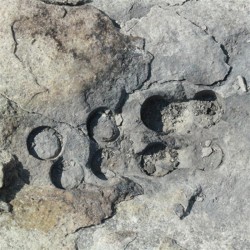Article Origin
Volume
Issue
Year
The historian who alerted media earlier in September to vandalism of a glacial rock he said to be covered in Aboriginal carvings and images, is dismayed his word is being called into question by the archeological community.
Despite questions over a lack of documented evidence, Stanley Knowlton, head of interpretive services at Head Smashed-In Buffalo Jump and member of the Piikani First Nation, maintains that historical etchings, described as pictographs or petroglyphs, existed on a glacial boulder known as the Glenwood Erratic before being destroyed by an act of vandalism.
He alleged on Sept. 17 that sometime during the previous week a drill, chemicals and a pressure washer were used to erase the carvings of a large face and early syllabic writing — evidence he says that could have suggested that the Blackfoot First Nations had written language before European migration.
Knowlton believes the vandalism was a culturally-motivated attack on First Nations’ history.
“I have been there several times and know what I saw, the damage was not there a month ago,” Knowlton said.
Knowlton’s comments come after a team of government archeologists investigated the site, located on the Riverside Hutterite Colony north of Glenwood and south of Fort Macleod, on Sept. 19 and 20. They determined there were no indications that pictographs or petroglyphs existed on the Glenwood Erratic.
“The bottom line is there is no evidence of pictographs on top of the rock,” said Alberta Culture spokesperson John Tuckwell, who was apprised of the on-site situation by the archeological team. “There is evidence of drilling on top of the rock but we think that is from rock sampling and not an act of vandalism. Based on an archeology analysis those holes in the rock are not new and have probably been there for years. There was also no evidence of any solvent, detergents or acid on the rock.”
Tuckwell added that shallow depressions, likely from snow and water erosion, may have been confused for etchings.
The ministry had no record of the site, Tuckwell said.
The Glenwood Erratic was also news to Blood Tribe Elder Francis Firstcharger, who pinpoints sites such as these across Alberta in order to educate Blackfoot youth.
“Most of the sites in southern Alberta I know about,” he said. “I only heard about this when I read about it.”
The Glenwood Erratic may just be coming to the forefront now, said Red Deer Museum Curator of History Michael Dawe, because archeological resources in Canada are spread so thinly.
“They’re playing catch up,” Dawe said of the government. “It would make sense that erratics would be religious sites to the first peoples on Alberta’s landscape and stories of vandalism to ancient sites in this province are not new.”
Knowlton, who states to have a background in archeology and geography, said he didn’t take photographs of the pictographs during the four times he visited the rock in the last year because the etchings, while very special, are not meant for us.
“There is a Native process,” he said. “When you find something, you just don’t open stuff up.”
The “Native way” is also why Knowlton said he did not report the vandalism to either the Cardston RCMP or the Blood Tribe Police Service.
The Cardston RCMP detachment conducted an investigation after being contacted by numerous media outlets, said Cpl. Charles Brown.
“There doesn’t look to be any validity to this on the surface so we are trying to determine why this was believed to be a historical site,” Brown said.
Despite having his findings brought into question, Knowlton says he will continue to search for sites with syllabic writing in order to prove his theories.
- 4593 views

